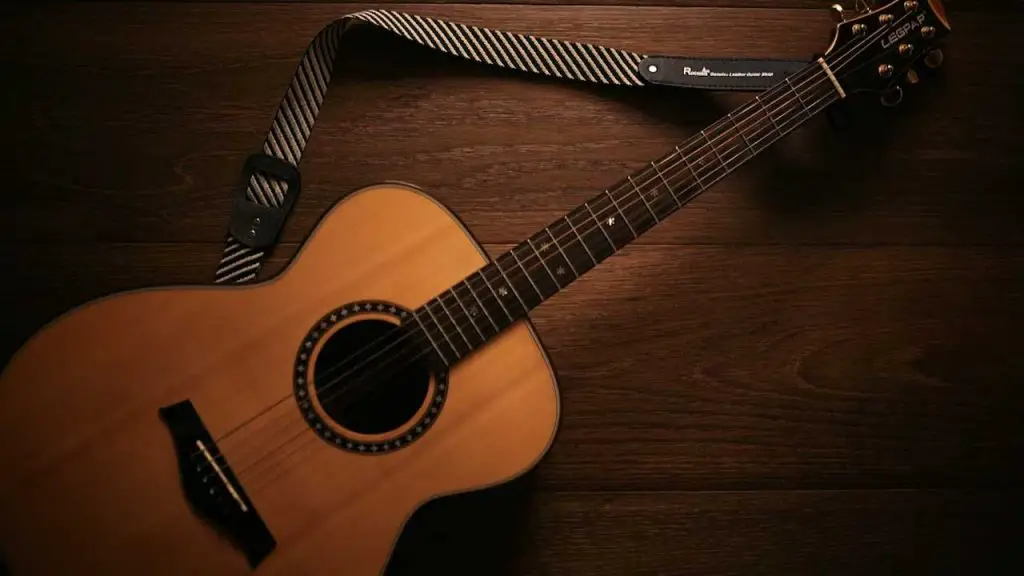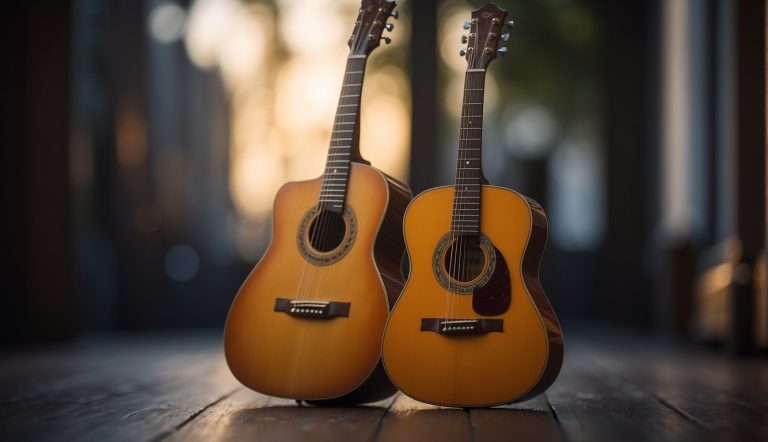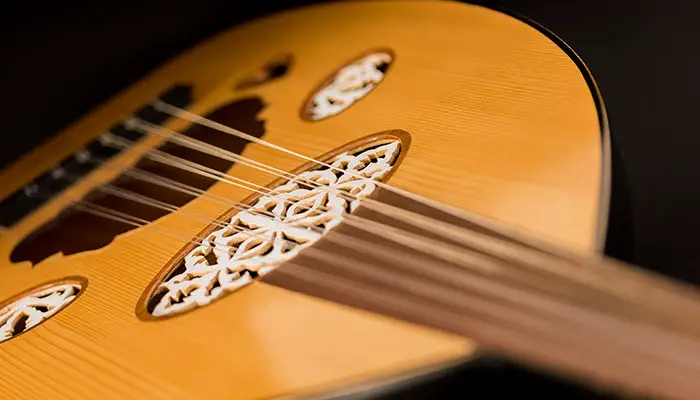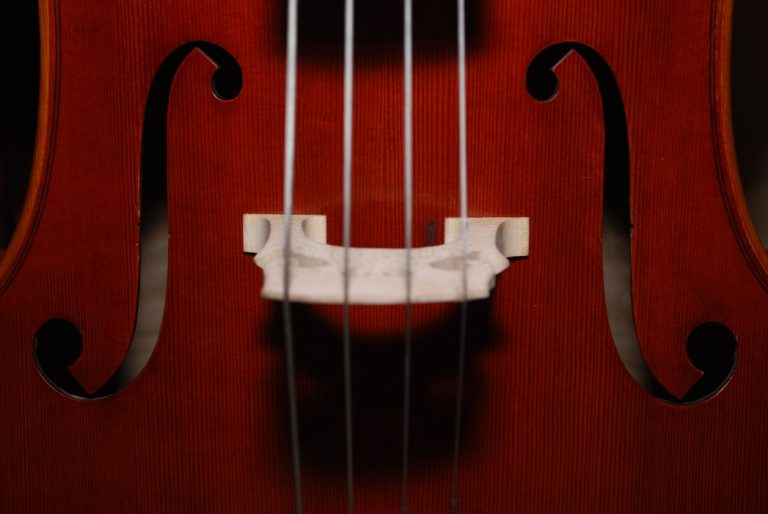Learning How to Play Acoustic Guitar: A Beginner’s Guide to Strumming Success
Folkstrings.com is reader-supported. When you buy through links on our site, we may earn a small commission.
Learning how to play the acoustic guitar is a rewarding journey that combines patience, creativity, and dexterity. As someone who has traversed this path, I can assure you that the process, while challenging at times, is immensely fulfilling.
From strumming your first chord to mastering a full song, each step in learning the acoustic guitar opens up new avenues for musical expression and enjoyment.

My personal experience began with understanding the instrument’s anatomy, followed by the basics of tuning and maintaining my guitar. Mastering chords and progressions was the next step, requiring regular practice to train my fingers to move fluidly across the fretboard. Progressing through each stage not only enhanced my playing skills but also deepened my relationship with the instrument, allowing me to extract a wide range of emotions and tones.
Key Points
- Approaching guitar learning with patience leads to rewarding progress.
- Regular practice is crucial for mastering chords and finger techniques.
- Understanding the instrument’s maintenance is part of overall skill development.
Table of Contents
Covering the Fundamentals…
When I first started learning to play the acoustic guitar, understanding the basics of instrument posture and pick usage was key to developing a good foundation. Patience and joy in the process immensely boosted my learning experience.
Holding Your Guitar
My posture is crucial when I hold my guitar. I make sure that the body of the guitar rests comfortably against my torso, with the bottom curve on my right thigh if I’m right-handed; left thigh if left-handed. It’s essential to keep my back straight and relaxed. Using a guitar strap even when sitting can help maintain consistent guitar posture and alleviate strain on my arms.
Using a Guitar Pick
As a beginner, using a guitar pick felt a bit awkward, but with practice, it became second nature. I hold the pick between the thumb and index finger of my strumming hand, with only a small part of the pick exposed to strike the strings. This gives me control and helps deliver a cleaner sound. I learned that there are various pick thicknesses, and finding the one that feels comfortable in my grip and suits my playing style made a significant difference.
Tuning and Basic Maintenance
Before we dive into strumming our favorite tunes, I want to talk about keeping our guitar in perfect pitch and ensuring it’s well taken care of. Proper tuning and maintenance will not only make our guitar sound its best but also prolong its life.
How to Tune
When I tune my guitar, I’m looking to achieve the standard tuning of E-A-D-G-B-E, from the lowest (thickest) string to the highest (thinnest) string. I often use an electronic tuner, which makes this process very straightforward. Here’s a quick step-by-step:
- Turn on your electronic tuner.
- Pluck the low E string and check the tuner to see if it registers as ‘E’.
- Adjust the tuning peg for the low E string until the tuner indicates the pitch is correct.
- Repeat steps 2 and 3 for each string going from the thickest to thinnest.
Remember, if you are not using an electronic tuner, you can use guitar tuners that clip onto the headstock or even tuning apps on your phone.
Caring for Your Guitar
My guitar feels like an extension of myself, so I always make sure I’m taking great care of it. Here’s what I focus on to keep my guitar in tip-top shape:
- Cleaning: Wipe down your guitar with a soft, dry cloth after playing to remove any fingerprints or oils.
- Storage: Store your guitar in a case when not in use to protect it from dust and humidity changes.
- Humidity: Be mindful of humidity levels; guitars thrive in an environment with about 45-55% humidity.
- String Changing: Change strings regularly to maintain tone and ensure the neck stays in proper tension.
Remember, routine maintenance and careful handling will keep our guitar not just playable, but resonant and beautiful for years to come.
Learning Chords and Progression
Mastering chords and their progressions is the foundation for playing acoustic guitar. It’s where I began my journey, and it’s thrilling to see how a sequence of chords can create a harmonious melody.
First Chords to Learn
When I first started learning guitar, I found a few chords that are considered the easiest for beginners due to their finger placement and the fact that they require fewer fingers to hold down the strings. Here are the first chords I learned:
- C Major: Place your ring finger on the third fret of the A string, middle finger on the second fret of the D string, and index finger on the first fret of the B string.
- G Major: Place your ring finger on the third fret of the low E string, middle finger on the second fret of the A string, and pinkie on the third fret of the high E string.
- D Major: Place your index finger on the second fret of the G string, ring finger on the third fret of the B string, and middle finger on the second fret of the high E string.
- E Minor: Place your middle finger on the second fret of the A string and ring finger on the second fret of the D string.
These chords are not only fundamental to play countless songs but also easy to move between, which helped me improve my dexterity. Regular practice of these chords allowed me to smoothly transition to others as I progressed.
Understanding Chord Progressions
Chord progressions are essential in music; they describe the sequence of chords played over a segment of a song. The progression often follows a pattern that gives the song a sense of movement and resolution. Knowing how to identify these patterns helped me understand the structure of songs and anticipate chord changes. Here are two common progressions I familiarized myself with:
- I-IV-V-I (C-F-G-C): This is one of the most classic chord progressions in Western music. You start with the root chord (C Major), move to the fourth scale note (F Major), then to the fifth (G Major), and back to the root.
- ii-V-I (Dm-G-C): Commonly found in jazz, this progression moves from the second minor chord in the key, to the dominant chord, and resolves on the tonic chord.
Learning to play these progressions involved practicing the changes between chords and ensuring I kept the rhythm consistent. I found that counting beats out loud and using a metronome were invaluable tools for keeping time. Paying attention to the placement of my fingers on the frets and gradually increasing speed without sacrificing accuracy also made a significant difference.
Developing Your Skills
As you embark on the journey of mastering the acoustic guitar, remember that the bedrock of excellence is rooted in consistent practice and honing specific techniques. I’ll share with you the importance of mastering strumming patterns and understanding the fingerstyle basics, elements that are critical to developing your skills.
Strumming Patterns
Strumming might initially feel awkward, but it’s about establishing a steady rhythm that serves as the heartbeat of your music. Start with simple downstrokes on the quarter notes, and as you build confidence, incorporate upstrokes to create more intricate patterns. My practice sessions include:
- Daily Strumming Exercises:
- Day 1: Downstrokes only to get the timing right.
- Day 2: Down and upstrokes on quarter and eighth notes.
This routine has been instrumental in improving my strumming technique, enhancing my timing, and reducing finger pain as I build calluses.
Fingerstyle Basics
When I first explored fingerpicking, I was fascinated by the melodies I could pull from my guitar. Starting with basic patterns, I allocated time each day to practice fingerstyle exercises, which eventually allowed me to weave intricate musical textures. My beginner steps included:
- Assigning each finger to a string and practicing plucking in sequence.
- Focusing on getting clear and even tones.
- Gradually speeding up as my fingers became more confident.
By combining these fingerpicking practices with knowledge of music theory, I started to integrate advanced techniques into my playing. Although acoustic guitar lessons were beneficial, much of my improvement came from personal dedication and practice.
Getting to Know Your Instrument

Before diving into how to play, it’s important for me to understand the parts of my acoustic guitar and recognize the different types available. Each component plays a crucial role in the sound and playability of the guitar.
Anatomy of the Acoustic Guitar
My acoustic guitar is made up of several key parts, each contributing to its unique sound. Let’s take a closer look at each component:
- Headstock: This is where I can find the tuners or machine heads, which are essential for tuning the strings of my guitar.
- Neck: Attached to the headstock, the neck is where the fretboard, or fingerboard, is located. This is where I press down the strings to create different notes.
- Body: The body of the guitar is the large, hollow section that amplifies the sound. It includes the soundhole, the bridge, and often a pickguard to protect the wood.
- Soundhole: Positioned in the center of the body, the soundhole allows the sound to resonate and escape, contributing to the tone and volume of the guitar.
- Bridge: Located on the body of the guitar, this is where the strings are anchored.
- Strings: Typically, my acoustic guitar has six strings, each with a different pitch.
The type of wood used in the construction of my guitar also greatly affects the sound. For instance, mahogany is known for its rich, warm tones, while spruce can offer a brighter sound.
Types of Acoustic Guitars
When it comes to acoustic guitars, there are a few main styles that I’ve come across:
- Classical: Usually has nylon strings, which are gentler on my fingers. This type is often recommended for beginners.
- Steel-string: This type is common in folk, country, and rock music. It has steel strings that can be tougher on the fingers but produce a brighter sound.
- Dreadnought: Known for its large body and strong sound projection, this type is a popular choice for many styles of music.
- Parlor: Smaller in size, these guitars are ideal for someone like me who prefers a more comfortable and intimate playing experience.
Each type of guitar offers a different sound and playing experience, so selecting the right one can influence my journey in learning how to play acoustic guitar.
Frequently Asked Questions
In this section, I’ll address some common questions that beginners have when learning to play acoustic guitar, including selecting resources, choosing an instrument, and understanding the essentials of self-teaching.
What are the best resources for a beginner to learn guitar?
I’ve found that combining various types of resources works best for beginners. Online tutorials, instructional books, and apps like GuitarApprentice can be exceptionally helpful.
These provide structured learning and practice exercises that can accelerate the process of becoming proficient.
Can you suggest a good acoustic guitar for a beginner?
Absolutely, a comfortable and playable guitar is crucial for learning. I usually recommend that beginners look for guitars with a good balance of quality and affordability.
Brands like Yamaha and Fender offer models that are often praised for their playability and sound, suitable for new players.
What are the fundamental chords I should learn as a novice guitar player?
The fundamental chords that serve as the building blocks for many songs are A, C, D, E, G, and the minor variants of these.
I encourage learning these chords first, as they will allow you to play a vast repertoire of songs and develop your finger strength and dexterity.
Is it possible to effectively teach yourself to play guitar and, if so, how?
Yes, it’s possible to teach yourself to play guitar. It involves a commitment to daily practice, seeking out quality instructional material and resources, and being patient with your progress.
Tools like augmented reality to facilitate learning can be particularly beneficial for visualizing finger placement and technique.
What are the first steps I should take when starting to learn guitar?
When you’re just starting, get familiar with your guitar, learn how to hold it correctly, and practice finger exercises to build strength.
I suggest starting with learning a few basic chords and progressing to simple songs that use these chords, which helps build muscle memory and confidence.
How much time does it usually take to become proficient at playing the acoustic guitar?
The time it takes to become proficient can vary widely, but with consistent daily practice, you might start to feel comfortable with basic playing within a few months.
Achieving proficiency depends on practice quality, personal goals, and the difficulty of pieces you wish to play. Remember, learning an instrument is a marathon, not a sprint.
Author Profile
-
Daniel Johnstone is an English writer with a love for stringed instruments from around the world.
He shares his love for these instruments through his writing for folkstrings.com, a website dedicated to all things related to folk string music.
Daniel's passion for music started at a young age, and he has since become an accomplished musician, playing guitar, cavaco, and recently, the harp.
His dedication to learning and sharing his knowledge of stringed instruments is evident in his insightful and engaging blog posts. Whether you're a seasoned musician or a beginner, Daniel's writing is sure to inspire and entertain you.
When he's not playing music or writing, you can find Daniel exploring new instruments and seeking out new sounds to share with his readers.
Latest entries
 AutoharpApril 4, 2024What Is the Autoharp Made Of: Exploring Its Materials and Craftsmanship
AutoharpApril 4, 2024What Is the Autoharp Made Of: Exploring Its Materials and Craftsmanship AutoharpApril 4, 2024Is Autoharp Easy to Play? Unveiling the Truth for Beginners
AutoharpApril 4, 2024Is Autoharp Easy to Play? Unveiling the Truth for Beginners AutoharpApril 4, 2024What Is an Autoharp Worth? Your Guide to Pricing and Value
AutoharpApril 4, 2024What Is an Autoharp Worth? Your Guide to Pricing and Value AutoharpApril 4, 2024Are Autoharp and Zither the Same Thing? Unraveling String Instrument Myths
AutoharpApril 4, 2024Are Autoharp and Zither the Same Thing? Unraveling String Instrument Myths
Affiliates:
This post may contain affiliate links that at no additional cost to you, the site may earn a small commission. We only recommend products we would use ourselves and all opinions expressed on this site are our own.
Accuracy Advice:
While we strive to provide up-to-date and accurate information, the content in this article may not reflect the most current research or medical guidelines. We encourage readers to do further research and consult with professionals for more personalized advice.
Our Recommendations:
The products and services mentioned in any of our articles are recommended based on our independent research and personal experience. We are not sponsored by any company. We aim to suggest products and services we believe are of high quality and could be beneficial to our readers.





